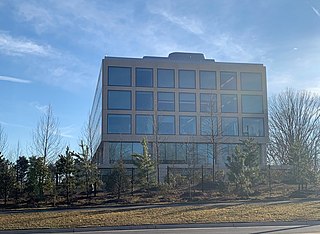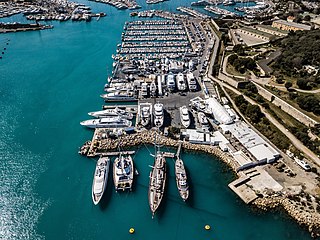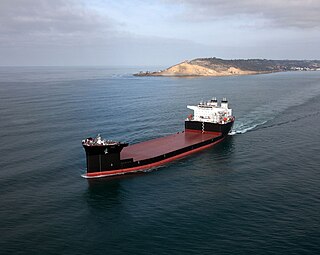
General Dynamics Corporation (GD) is an American publicly traded aerospace and defense corporation headquartered in Reston, Virginia. As of 2020, it was the fifth-largest defense contractor in the world by arms sales, and fifth largest in the United States by total sales. The company is a Fortune 100 company, and was ranked No. 94 in 2022.

A shipyard, also called a dockyard or boatyard, is a place where ships are built and repaired. These can be yachts, military vessels, cruise liners or other cargo or passenger ships. Compared to shipyards, which are sometimes more involved with original construction, dockyards are sometimes more linked with maintenance and basing activities. The terms are routinely used interchangeably, in part because the evolution of dockyards and shipyards has often caused them to change or merge roles.

Vigor Shipyards is the current entity operating the former Todd Shipyards after its acquisition in 2011. Todd Shipyards was founded in 1916, which owned and operated shipyards on the West Coast of the United States, East Coast of the United States and the Gulf. Todd Shipyards were a major part of the Emergency Shipbuilding Program for World War II.

Fore River Shipyard was a shipyard owned by General Dynamics Corporation located on Weymouth Fore River in Braintree and Quincy, Massachusetts. It began operations in 1883 in Braintree, and moved to its final location on Quincy Point in 1901. In 1913, it was purchased by Bethlehem Steel, and later transferred to Bethlehem Shipbuilding Corporation. It was sold to General Dynamics in 1963, and closed in 1986. During its operation, yardworkers constructed hundreds of ships, for both military and civilian clients.

USNS Robert E. Peary (T-AKE-5) is a Lewis and Clark-class dry cargo ship in the United States Navy. She is the fourth Navy ship named for Arctic explorer, Rear Admiral Robert E. Peary (1856–1920).

USNS Amelia Earhart (T-AKE-6), a Lewis and Clark-class dry cargo ship is the only ship of the United States Navy to be named for noted American aviation pioneer and women's rights advocate Amelia Earhart (1897–1937). The contract to build the ship was awarded to National Steel and Shipbuilding Company (NASSCO) of San Diego, California, on 27 January 2004. Her keel was laid down at the end of May 2007 at General Dynamics' NASSCO shipyard. In early 2007, Alex Mandel along with members of the Amelia Earhart Society (AES) and Amelia Earhart Research Association (AERA) successfully petitioned the naming of the ship.

USNS Carl Brashear (T-AKE-7) is a Lewis and Clark-class dry cargo ship of the United States Navy, named in honor of Master Chief Boatswain's Mate Carl Brashear (1931–2006), one of the first African-Americans to become a US Navy Master Diver, despite having lost a leg in the 1966 Palomares incident.

USNS Wally Schirra (T-AKE-8) is a Lewis and Clark-class dry cargo ship of the United States Navy, named in honor of Captain Wally Schirra (1923–2007), one of the Mercury Seven astronauts, who flew three times in space, on Mercury 8, Gemini 6A, and Apollo 7.

USNS Soderman (T-AKR-317) is a Large, Medium-Speed Roll-on/Roll-off Ship (LMSR) and is part of the Military Sealift Command. The USNS Soderman is in the Preposition Program which stations ships across the world with military equipment. The Soderman is Watson-class vehicle cargo ship built by National Steel and Shipbuilding Company. The ship was launched on April 26, 2002 and put into service on the 24 of September 2002. The ship was named after Private First Class William A. Soderman, a Medal of Honor Recipient for World War II.

USNS Charles Drew (T-AKE-10) is a Lewis and Clark-class dry cargo ship of the United States Navy, named in honor of Dr. Charles R. Drew (1904–1950), who developed improved techniques for blood storage, and applied his expert knowledge in developing large-scale blood banks early in World War II, saving thousands of Allied lives.

USNS Medgar Evers (T-AKE-13) is a Lewis and Clark-class dry cargo ship of the United States Navy. As part of the Navy's Combat Logistics Force, her mission is to deliver ammunition, provisions, dry stores, refrigerated food, spare parts, potable water, and diesel and jet fuel to U.S. Navy and allied ships while at sea. The ship is named for civil rights movement activist Medgar Evers, a World War II veteran who was assassinated in 1963. The Navy announced the naming on 9 October 2009.

An Expeditionary Transfer Dock (ESD), formerly the Mobile Landing Platform (MLP), is designed to be a semi-submersible, flexible, modular platform providing the US Navy with the capability to perform large-scale logistics movements such as the transfer of vehicles and equipment from sea to shore. These ships significantly reduce the dependency on foreign ports and provide support in the absence of port availability. The class also houses a sub-class variant called the Expeditionary Mobile Base (ESB), formerly the Afloat Forward Staging Base (AFSB).

USNS Montford Point (T-ESD-1),, the lead ship of her class of Expeditionary Transfer Docks (ESD), is a ship named in honor of African American Marine Corps recruits who trained at Montford Point Camp, North Carolina, from 1942 to 1949. After $115 million was allocated for long-lead time material and advanced design efforts, in late 2010 General Dynamics's National Steel and Shipbuilding Company was awarded the contract, worth approximately $500 million, to build the first of three planned vessels.

USNS John Glenn (T-ESD-2), is a United States Navy Expeditionary Transfer Dock ship named in honor of John Glenn, a Naval Aviator, retired United States Marine Corps colonel, veteran of World War II and the Korean War, astronaut, and United States senator.
The Type C7 ship(Lancer Class) is a United States Maritime Administration (MARAD) designation for a cargo ship and the first US purpose-built container ship. The vessels were constructed in US shipyards and entered service starting in 1968. As US-built ships they were Jones Act qualified for shipments between US domestic ports. Under the Jones Act, domestic US maritime trade is restricted to US-built and flagged vessels of US owners and manned by predominantly US-citizen crews. The last active Lancer container-configured ship was scrapped in 2019. Lancers of the vehicle Roll-on/Roll-off (RO/RO) configuration remain held in the Ready Reserve Force, National Defense Reserve Fleet and the US Navy Military Sealift Command. All are steam powered.

Todd Pacific Shipyards, Los Angeles Division was a shipyard in San Pedro, Los Angeles, California. Before applying its last corporate name, the shipyard had been called Los Angeles Shipbuilding & Dry Dock Company and Todd Shipyards, Los Angeles Division. Under those three names, the San Pedro yard built at least 130 ships from 1917 to 1989.

USS Hershel "Woody" Williams (ESB-4) is a Lewis B. Puller-class expeditionary mobile base (ESB), currently in service with the United States Navy. The ship is also a sub-variant of the Montford Point-class expeditionary transfer dock (ESD). The ESDs are operated by the Navy's Military Sealift Command with predominantly civilian crews, while the ESBs, owing to the nature of their operations, have been commissioned and commanded directly by the U.S. Navy. The ship was named in honor of Hershel W. "Woody" Williams in an announcement by then-Secretary of the Navy Ray Mabus, on 14 January 2016. Williams was a Marine who was awarded the Medal of Honor in the Battle of Iwo Jima, during World War II.

The John Lewis class is a class of fleet replenishment oilers which began construction in September 2018. The class will comprise twenty oilers which will be operated by Military Sealift Command to provide underway replenishment of fuel and limited amounts of dry cargo to United States Navy carrier strike groups, amphibious ready groups, and other surface forces, to allow them to operate worldwide.

The San Clemente-class oil tanker is a class of oil tankers built by National Steel and Shipbuilding Company (NASSCO), San Diego. The size places them in the category of super tankers. They were built to serve the Trans-Alaska Pipeline System. At the time of completion National Steel and Shipbuilding Company was equally owned by Kaiser Industries Corporation and Morrison-Knudsen Company, Inc.

USS John L. Canley (ESB-6) is the fourth Lewis B. Puller-class expeditionary mobile base (ESB) of the United States Navy, and the first ship to be named for Medal of Honor recipient John L. Canley. John L. Canley was constructed in San Diego, California by the National Steel and Shipbuilding Company (NASSCO). Like her sister ships, she is also a sub-variant of the Montford Point-class expeditionary transfer dock (ESD). The ESDs are operated by the Navy's Military Sealift Command with predominantly civilian crews, while the ESBs, owing to the nature of their operations, have been commissioned and are operated directly by the Navy with military personnel.




















